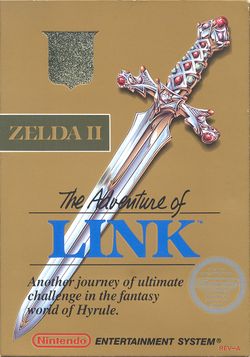| Don't like the ads? Then create an account! Users with accounts have more options than anonymous users. |
Difference between revisions of "Zelda II: The Adventure of Link"
From Triforce Wiki, a The Legend of Zelda wiki
Jump to navigationJump to search
(removed ; collector's edition) |
|||
| Line 9: | Line 9: | ||
|modes=Single player | |modes=Single player | ||
}} | }} | ||
'''''Zelda II: The Adventure of Link''''' is the second installment of ''[[The Legend of Zelda (series)|The Legend of Zelda]]'' series and a direct follow-up of ''[[The Legend of Zelda (video game)|The Legend of Zelda]]''. It was first released for the [[Famicom Disk System]] in Japan and overseas on the [[Nintendo Entertainment System]] about a year later. | '''''Zelda II: The Adventure of Link''''' is the second installment of ''[[The Legend of Zelda (series)|The Legend of Zelda]]'' series and a direct follow-up of ''[[The Legend of Zelda (video game)|The Legend of Zelda]]''. It was first released for the [[Famicom Disk System]] in Japan and overseas on the [[Nintendo Entertainment System]] about a year later. Gameplay-wise, it is vastly different from its predecessor, being comparable to an RPG and having platforming elements. | ||
{{Games}} | {{Games}} | ||
[[Category:Console games]] | [[Category:Console games]] | ||
[[Category:Handheld games]] | [[Category:Handheld games]] | ||
[[Category:The Legend of Zelda series]] | [[Category:The Legend of Zelda series]] | ||
Revision as of 05:28, May 5, 2019
 This article is a stub. You can help Triforce Wiki by expanding it.
This article is a stub. You can help Triforce Wiki by expanding it.
| Zelda II: The Adventure of Link | |
|---|---|

| |
| Developer(s) | Nintendo EAD |
| Publisher(s) | Nintendo |
| Release date | Famicom Disk System: Nintendo Entertainment System |
| Genre(s) | Action role-playing |
| Console(s) | Famicom Disk System, Nintendo Entertainment System, Game Boy Advance, Virtual Console (Wii, Nintendo 3DS) |
| Mode(s) | Single player |
Zelda II: The Adventure of Link is the second installment of The Legend of Zelda series and a direct follow-up of The Legend of Zelda. It was first released for the Famicom Disk System in Japan and overseas on the Nintendo Entertainment System about a year later. Gameplay-wise, it is vastly different from its predecessor, being comparable to an RPG and having platforming elements.